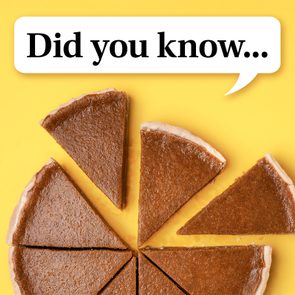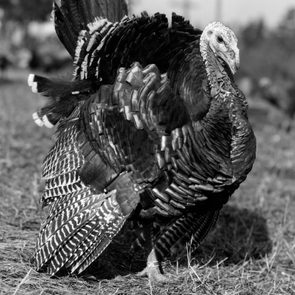Here’s Why the President Pardons a Turkey Every Thanksgiving
Updated: Feb. 12, 2023

Every year, the U.S. has an official Presidential turkey pardon ceremony, saving a live bird from a Thanksgiving table. Why does the Commander-in-Chief do this, where did the tradition start, and what happens to the turkey afterwards?
Some American traditions are admittedly pretty strange. We ask a groundhog for weather forecasts. We chuck pumpkins for fun. But among the most head-scratching of them all has got to be one of the best-known Thanksgiving traditions: the presidential turkey pardon. Why does the president pardon a turkey every Thanksgiving?
Every year, the U.S. president holds a National Thanksgiving Turkey Presentation sparing a turkey from a Thanksgiving table. Instead, the birds are sent to a farm to live out their lives in peace—though it’s a bit more complicated than that. And while the presidential turkey pardon is a fun tradition, the history of Thanksgiving is actually much grimmer than you might know.
Who was the first president to pardon a turkey?
That’s a more complicated answer than you might imagine. The presidential turkey pardon tradition might have stemmed from Abraham Lincoln, who made Thanksgiving an official U.S. holiday in 1863. According to 19th-century White House reporter Noah Brooks, Lincoln’s son Tad got upset when he found out someone was going to kill the live turkey that had been brought for the presidential family’s Christmas dinner in 1863. Eventually, Tad’s “plea was admitted and the turkey’s life spared,” Brooks writes.
Of course, that was Christmas poultry, not Thanksgiving. A decade later, though, Rhode Island poultry dealer Horace Vose started sending Thanksgiving and Christmas turkeys to the first family. Vose was the White House’s unofficial turkey provider for more than 40 years after that first turkey to President Ulysses S. Grant, but by 1914, Americans from around the country were sending live turkeys to the first family for the holidays.
People often incorrectly date the official pardoning ceremony back to 1947 with Harry Truman. That myth probably stems from the fact that the National Turkey Federation—which runs the modern presidential turkey pardon ceremonies—sent a president a turkey for the first time that year. The thing is, Truman didn’t spare that bird’s life, according to NPR. He ate it. We can’t help but wonder if presidents pull apart the turkey wishbone!
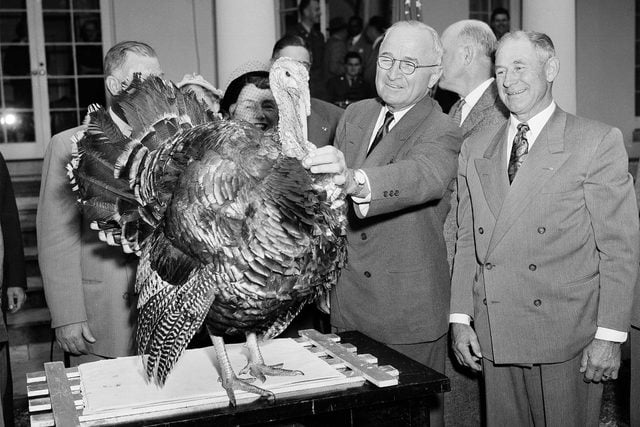
The first president to throw a ceremony rescuing a bird from being doomed to the Thanksgiving table seems to be John F. Kennedy in 1963, according to the White House Historical Association. That year, the turkey had a heart-wrenching “Good Eating, Mr. President!” sign around its neck. Reportedly, JFK said, “We’ll just let this one grow,” and had the bird sent back to the farm. The Los Angeles Times ran an article about the event calling it a “presidential pardon.” And so the presidential turkey pardon tradition began.
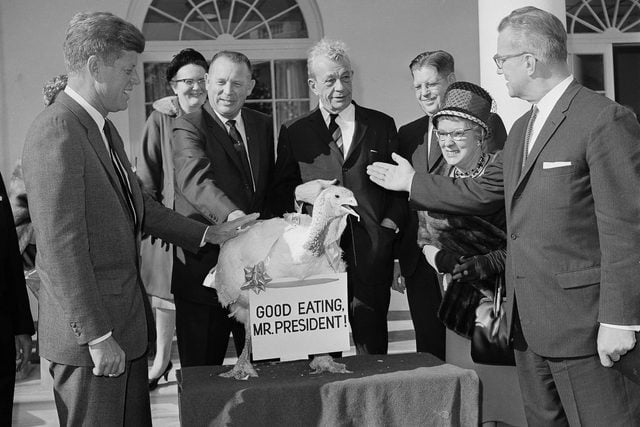
Turkey pardons throughout history
Over the years, the presidential turkey pardon started taking off. Ronald Reagan was the first to use the word “pardoned” about a turkey in 1987—but it was all in context. After talking about Charlie, the turkey Reagan sent to a pet farm, a reporter probed the president about pardoning Oliver North and John Poindexter over the Iran-Contra affair. “If they’d given me a different answer on Charlie and his future, I would have pardoned him,” Reagan joked. Those pardoned turkeys are definitely feeling pretty grateful! Find out our favorite things to be grateful for.
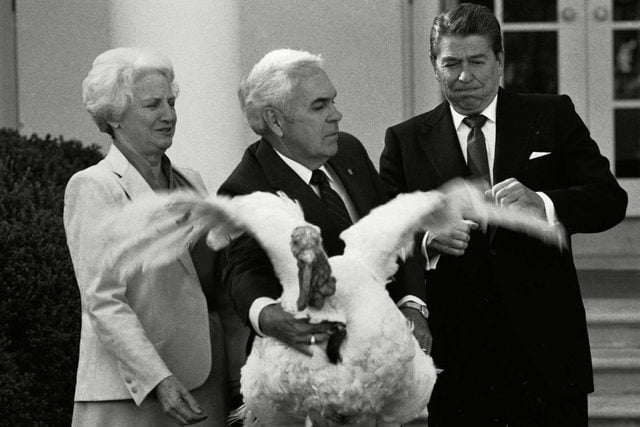
It wasn’t until George H. W. Bush’s first Thanksgiving as president in 1989 that the pardon became “official.” When animal-rights activists showed up to protest the turkey presentation, Bush assured them that the turkey would not be harmed. “‘Reprieve,’ ‘keep him going,’ or ‘pardon’: It’s all the same for the turkey, as long as he doesn’t end up on the president’s holiday table,” he told reporters. “Let me assure you, and this fine tom turkey, that he will not end up on anyone’s dinner table, not this guy. He’s granted a presidential pardon as of right now.”
From then on, presidents have been pardoning birds approaching every Thanksgiving. Each year, the National Turkey Federation chooses one or two turkeys for the annual presentation. The turkeys are chosen based on their appearance and temperament: They need to be able to tolerate large crowds and loud noises for the pardoning ceremony.
As the event gets closer, the turkeys become social media famous, with silly names like Tater and Tot in 2016, or Mac and Cheese in 2014. And no, the presidents don’t take it too seriously. During the 2014 ceremony, President Barack Obama said he was sparing the turkeys from a “terrible and delicious fate” and later admitted it’s “a little puzzling that I do this every year.” Puzzling, perhaps, but fun nonetheless. For your own quips on the big day, try these funny Thanksgiving quotes to share around the table.
What happens to the turkeys that are pardoned?
Bread and Butter, the turkeys pardoned by Donald Trump in 2019, created some buzz when it was reported that they stayed in a $422 hotel room the night before their pardoning. But what happens to the turkeys after the president pardons them?
The turkeys are often sent to farms to live out the rest of their days. First Lady Patricia Nixon sent a bird to a children’s farm in 1973. One given to Rosalynn Carter in 1978 went to a mini zoo at Evans Farm Inn. Nancy Reagan accepted the turkey on her husband’s behalf each year and chose a nearby farm or zoo. George Washington’s estate, Mount Vernon, was a post-pardon haven for turkeys in the Obama era, but that stopped when they were deemed not “historically accurate” to Washington’s time.
Since 2016, the pardoned turkeys have been sent to Gobbler’s Rest, an area of Virginia Tech’s College of Agriculture and Life Sciences, where they’re cared for by veterinarians and vet students. Each year, the college hosts an open house for the public to meet the special turkeys. In 2020, the two turkeys pardoned by President Trump, Corn and Cob, were sent to live out the rest of their days at Iowa State University.
Despite the expert care and plush accommodations at Gobbler’s Rest, most turkeys don’t stay long. This is because the turkeys rarely live past a few months after receiving their pardons! Turkeys who are bred for Thanksgiving dinner have a much shorter life expectancy than wild turkeys. This is because Americans prefer a large bird with plenty of meat for carving and enjoying, which means that farmers must feed their turkeys a high-protein diet to increase their weight. A turkey’s organs, however, are not equipped to support the extra weight, so turkeys who are bred to be eaten usually live for months rather than years. While their life expectancies have improved in recent years—and 2016’s Tater “exceeded all expectations” and lived for two years—the pardoned turkeys usually do not see another Thanksgiving. The veterinarians at Virginia Tech explain that this is to be expected in domestic turkeys.
OK, so maybe that was a bit of a bummer. Lighten the mood with these Thanksgiving memes, and find out everything you need to know about another cherished tradition: the Macy’s Thanksgiving Day parade.
Sources:
- History: “President Lincoln proclaims official Thanksgiving holiday”
- The White House Historical Association: “Which president started the tradition of pardoning the Thanksgiving turkey?”
- Truman Library: “Did Truman Pardon a Turkey?”
- NPR: “The Strange Truth Behind Presidential Turkey Pardons”
- The White House Historical Association: “Pardoning the Thanksgiving Turkey”
- NBC News: “Presidential turkey pardons, not as long a history as you might think”
- Administration of Ronal Reagan
- Time: “A Presidential Turkey Flap: Ronald Reagan and the Bonkers Birds”
- CTV News: “Turkeys stay in US$422 hotel room before getting pardoned by Trump”




















